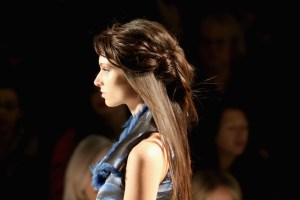Antonio Corral Calero styles a model backstage at the Katya Leonovich Fall 2013 fashion show during Mercedes-Benz Fashion Week at Lincoln Center on February 9, 2013 in New York City.
Antonio Corral Calero learned the tricks of the hairstyling trade from esteemed Spanish hair designer Luis Llongueras, and went on to work for Yves St. Laurent, Christian Dior and M.A.C. Now as the artistic director of Moroccanoil, he travels the world as an expert stylist and brand ambassador. Here, he talks tresses with TIME.
How did you get started as a hairstylist?
Twenty years ago. I come from Barcelona, Spain, and I had a passion for hair since I was five years old. I grew up in a house with three sisters. I touched hair all the time and I loved it. I went to clothing design school; then I did makeup and hair at the same time. And then I moved to Italy, I moved to Paris, I lived in New York. I’ve been moving around and learning languages. It’s just passion. I knew what I wanted to do since the very beginning.
How much time do you have to create each look?
At Fashion Week, you don’t have much time. So I need to make sure that everybody is done in fifteen minutes maximum. The models come in—some of them from different shows—so we make sure we put the right product in, texturize it, blow dry it, and just create the hair look. It’s fifteen minutes. It’s still elaborate, but it’s not crazy.
(MORE: Fashion Week Backstage: 5 Questions with Photographer Randy Brooke)

A model walks in the Katya Leonovich Fall 2013 fashion show on February 9, 2013 in New York City.
How did you decide on the hair look for this show [Katya Leonovich]?
I would say that it takes two to tango, so first I meet with the designer. Katya is very inspirational and she has crazy ideas that somehow work. She wanted to do something that was like a woman that comes out of a cocoon. She told me it has to be ethereal looking. She wanted to somehow have a halo around the hair, so we’re trying to create either a halo or like a turban. Some of the girls have fine hair, so we use extensions to create that look. We blow-dried it straight, used Moroccanoil’s new Heat Styling Protection and flatironed it. When everything was done, we pinned some of the extensions in the back of the hair and [brought the hair] across and pinned it behind the ear, and we did the opposite from the other side. And we started twisting it like that, three or four times, until we created the texture that we want. For us it was important to have two textures: straight, silky beautiful hair, and then a much more rough cuticle, texturized hair on top. Rather than putting in any accessories, I think the accessory this time is hair.
Where do you find inspiration for the hairstyles you create?
We get inspired by real people on the streets. From New York to Japan to Milan to Barcelona to London—if you walk around and look around, you always find someone who has something quite special. And that’s my job. I just came back from Japan not too long ago, and I would never have expected to see so many blonde women in Japan. I take trips sometimes just to inspire myself.
Have you ever had any hair disasters?
I don’t think there’s such a thing as a hair disaster. Even when I did things that I wasn’t happy about, I still got inspired by something. Sometimes I’ve overprocessed hair. For blondes sometimes, it’s tricky when you do a lot of highlights. It can be quite damaging for the hair. But then I realized that I really like that texture. So there’s not such a thing as a hair disaster.

